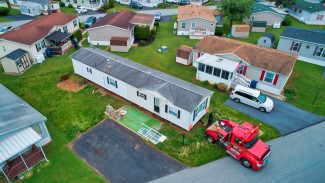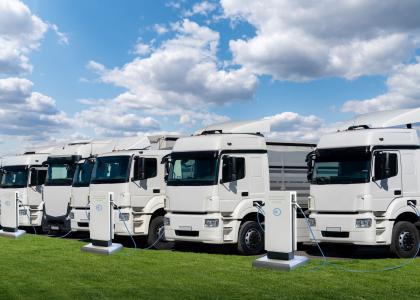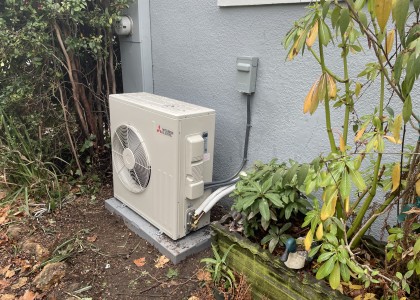New briefs identify federal funding and model programs to help lower energy bills and improve health and safety in a key affordable housing sector.
Manufactured homes represent the largest source of unsubsidized affordable housing in the United States, and roughly half of the residents are low-income. Because of historically weak energy standards and poor construction quality, these homes are often poorly insulated and not well sealed, leading to wasted energy and a variety of other health and safety hazards. As a result, residents face higher energy costs per square foot, increased rates of energy insecurity, rooms that are too hot or cold, and exposure to health risks like excessive mold.
States and utilities can improve quality of life for residents of manufactured housing with energy efficiency upgrades. Federal, state, and ratepayer funds can be used to deliver manufactured home retrofit or replacement programs to make energy, health, and safety improvements.
ACEEE has prepared three topic briefs providing states and utilities information on how they can help upgrade manufactured homes. The series includes:
- An overview of manufactured housing and its residents, common structural failure points, health concerns, and opportunities for retrofits
- Lessons learned from model state and utility retrofit and replacement programs
- Key federal funding opportunities for upgrading manufactured homes
Successful programs invest in building internal knowledge and expertise on manufactured housing, maintaining strong partnerships across housing and energy offices, and minimizing upfront costs for those most in need of home upgrades.
Assistance needed for people living in inefficient manufactured housing
The median household income of residents of manufactured homes is $35,280, about half that of residents of detached single-family homes ($76,000), and just below those in multifamily buildings ($40,800). As a result, manufactured housing residents often lack the resources to invest in home improvements or take on the debt needed for home replacement. Additionally, financing for manufactured homes can be difficult to access and usually comes with higher interest rates and shorter terms than typical mortgages.
Without adequate support to make improvements or upgrades feasible, people living in manufactured homes face significant risks to their health and well-being. For example, they are six to eight times more likely to die of heat-related deaths than residents of other homes. For homes in colder climates, inadequate insulation and drafty doors and windows can lead to excess cold, moisture, and mold, which are triggers of respiratory issues like asthma. A Maine resident participating in a replacement program reported being able to breathe more easily because of improved indoor air quality in temporary housing while awaiting the arrival of their new home.
Well-designed retrofit and replacement programs should support residents
Energy retrofit programs can lower energy use, increase affordability, and improve health and comfort for people living in manufactured homes. One Minnesota retrofit program found that residents could save an average of roughly $480 annually through upgrade measures such as air sealing, duct sealing, insulation, lighting replacement, and HVAC upgrades.
Retrofit efforts specifically targeted at manufactured homes usually yield better results than including them in programs designed to serve site-built homes. For example, retrofitting manufactured homes requires some specialized building expertise, and residents are less likely to be able to cover upfront costs or be interested in taking on new debt. In Louisiana, Entergy developed a retrofit program targeting manufactured housing parks: the program has no out-of-pocket costs for customers. In South Carolina, a group of electric utility cooperatives hosts the Help My House program, which uses low-cost federal loans to provide energy efficiency retrofits for manufactured homes. Help My House participants pay for retrofits through on-bill financing, and the energy bill savings more than outweigh the monthly costs.
States and utilities should be prepared to assess whether the cost of energy retrofits or repairs exceeds the value of the home. In those cases, well-funded home replacement programs are needed. Successful programs require a high level of coordination to provide residents with technical assistance and reasonable financing. In Oregon, a new law offers low-cost financing and grant assistance for manufactured home replacements. In coordination with state funding, Energy Trust of Oregon provides customer incentives for new homes that exceed minimum energy requirements. These efforts have led to life-changing outcomes for residents. After a home replacement, one Oregon family’s middle school-aged child was comfortable hosting friends in their home for the first time, and their performance at school improved.
States and utilities can tap energy upgrade incentives to expand housing affordability
States and utilities can use federal funding to establish manufactured housing efficiency programs or expand existing ones. The Rural Energy Savings Program, the Community Development Block Grants, and the new manufactured housing-specific Preservation and Reinvestment Initiative for Community Enhancement program can support investments in both retrofit and replacement projects. The Inflation Reduction Act provides substantial funding for household energy efficiency investments, including for manufactured housing. Our brief on the topic profiles 16 relevant funding opportunities from federal energy, housing, and health agencies.
With unprecedented federal funding available for home energy upgrades, states and utilities have an opportunity to work together to meaningfully improve quality of life for residents of manufactured homes. These briefs can guide states and utilities as they design new or expanded manufactured housing programs to improve energy efficiency and address health and safety concerns.




